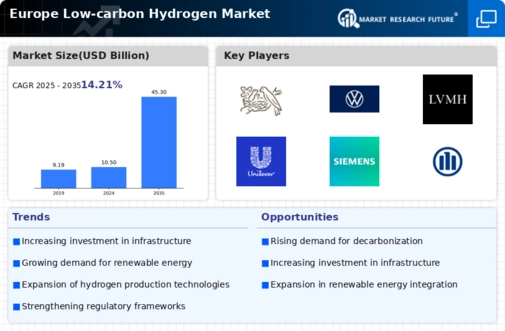Decarbonization of Heavy Industries
The low carbon-hydrogen market in Europe is being propelled by the urgent need for decarbonization in heavy industries such as steel, cement, and chemicals. These sectors are among the largest contributors to carbon emissions, and transitioning to hydrogen as a fuel source presents a viable solution. In 2025, it is estimated that the demand for low carbon-hydrogen in industrial applications could reach 5 million tonnes, driven by initiatives aimed at reducing carbon footprints. The European Union's Green Deal emphasizes the importance of hydrogen in achieving climate neutrality, thereby incentivizing industries to adopt hydrogen technologies. This shift not only aligns with environmental goals but also enhances energy security and reduces reliance on fossil fuels. As industries increasingly recognize the potential of low carbon-hydrogen, the market is likely to expand, creating new opportunities for innovation and investment.
Public Policy and Government Support
The low carbon-hydrogen market in Europe is significantly influenced by favorable public policy and government support. Various European nations are implementing policies that promote the adoption of hydrogen technologies, including subsidies, tax incentives, and grants for research and development. For instance, the European Commission has set ambitious targets for hydrogen production, aiming for at least 10 million tonnes of renewable hydrogen by 2030. This policy framework not only encourages private sector investment but also fosters collaboration between public and private entities. The commitment to reducing greenhouse gas emissions by 55% by 2030 further underscores the importance of hydrogen in achieving climate goals. Consequently, the supportive regulatory environment is likely to accelerate the growth of the low carbon-hydrogen market, making it an attractive sector for investors and innovators alike.
Growing Public Awareness and Acceptance
The low carbon-hydrogen market in Europe is experiencing a shift in public awareness and acceptance, which is crucial for its growth. As climate change concerns become more pronounced, the public is increasingly recognizing the role of hydrogen in achieving sustainable energy solutions. Educational campaigns and outreach initiatives are helping to demystify hydrogen technologies, fostering a more informed public discourse. In 2025, surveys indicate that approximately 70% of Europeans support the use of hydrogen as a clean energy source, reflecting a growing acceptance of its potential benefits. This shift in public perception is likely to influence policymakers and industry leaders, encouraging further investment and development in the low carbon-hydrogen market. As societal acceptance continues to rise, the market may witness accelerated adoption of hydrogen technologies across various sectors, including transportation, heating, and industrial applications.
Advancements in Hydrogen Storage Technologies
The low carbon-hydrogen market in Europe is benefiting from advancements in hydrogen storage technologies, which are crucial for the effective utilization of hydrogen as an energy carrier. Innovations in materials and methods for storing hydrogen are enhancing safety, efficiency, and cost-effectiveness. For example, the development of solid-state hydrogen storage systems is gaining traction, potentially reducing storage costs by up to 30% by 2027. These advancements are essential for addressing the challenges associated with hydrogen transport and distribution, thereby facilitating its integration into the energy system. As storage technologies improve, the viability of hydrogen as a mainstream energy source becomes more apparent, encouraging further investment in the low carbon-hydrogen market. This trend is likely to attract interest from various sectors, including transportation and energy, as stakeholders seek reliable and efficient solutions for hydrogen storage.
Investment in Renewable Energy Infrastructure
The low carbon-hydrogen market in Europe is experiencing a surge in investment aimed at enhancing renewable energy infrastructure. Governments and private entities are allocating substantial funds to develop facilities that produce hydrogen from renewable sources, such as wind and solar. In 2025, investments in renewable energy projects are projected to exceed €100 billion, significantly bolstering the low carbon-hydrogen market. This influx of capital is likely to facilitate the establishment of hydrogen production plants, storage facilities, and distribution networks, thereby creating a robust ecosystem for low carbon-hydrogen. Furthermore, the European Union's commitment to achieving carbon neutrality by 2050 is driving this investment trend, as stakeholders recognize the potential of hydrogen as a clean energy carrier. As a result, the low carbon-hydrogen market is poised for substantial growth, supported by a solid foundation of renewable energy infrastructure.


















Leave a Comment